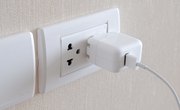Most electronic devices need some form of conversion to safely make use of the electricity from your wall outlet, whether that’s a simple reduction in voltage, conversion from AC to DC or both.
While it is possible to convert a 110 to a 12 volt electricity supply with a basic voltage transformer, if you’re switching between AC and DC electricity as well, you’ll need more than just a basic device like this. You can make it yourself, if you have some experience in electronics, but it’s much more efficient (and still affordable) to just buy one of many pre-made converters designed for the purpose.
AC vs. DC Circuits
Understanding the difference between AC and DC circuits is an important part of understanding the challenge in converting 110 V AC to 12 V DC. In short, DC stands for direct current and AC stands for alternating current, and while the power to your home is delivered in AC form, most devices take DC input. This is why AC-to-DC converters are so widely used, and in fact, most electronics like your laptop will come with one as standard.
Direct current is much easier to understand: The current flows in one direction with a constant voltage driving it. This is the type of energy that comes out of a battery, for example, which is constant (aside from a reduction in voltage as the battery drains).
Alternating current, on the other hands, alternates in direction, and the voltage creating the current oscillates between a positive and a negative value, in a sine wave. AC is used for home and office power supplies because it’s easier to transport over long distances.
Voltage Transformers
The voltage of your power supply essentially tells you how much of a “kick” it has to get current flowing. A higher voltage can produce more current, provided that it’s connected to the same circuit (or anything with the same resistance). However, if the voltage you’re using as a power supply is more than the device you’re powering can handle, it can damage the device.
That’s why transformers are used, because they convert voltages from higher to lower values or vice-versa. A transformer consists of two coils of wire, each wrapped around an iron “core,” with one attached to the power supply and one leading to the device.
The electricity from the first coil produces a magnetic field, with the help of the core, and this magnetic field induces a current in the secondary coil. The difference between the number of wraps around each core causes the change in the voltage of the power supplied to that put out.
Finding a 110 to 12 Volt Converter
To convert 110 V AC to 12 V DC, you simply need to buy a converter designed for the purpose, from an electronics store or online, both of which will have many options. The best advice is to check the device you’re looking to power to find the input voltage and the input current, and buy a converter where the output voltage and current match these values.
If you’re looking for a 12-V power supply, you already know what this will need to be, but be sure to check the current as well. You should also check that the converter accepts the appropriate voltage from the wall outlet (labeled as the input), which will be 110 V if you’re looking for a 110- to 12-volt converter.
Finally, check the polarity on the both the device you’re powering and on the adapter itself. Polarities are usually shown with a series of three circles, with the central one having an inner (solid color) core and an outer curve that doesn’t form a full circle.
There are positive and negative symbols in the outer circles, and these are connected to either the central core or the outer curve on the central symbol. If the positive sign is on the right (and connects to the central core) then it has a positive polarity, and if the negative sign does this, it has a negative polarity.
Provided you match all the polarity, voltage and current on your adapter and the device, and ensure the adapter can accept the voltage supply from your outlet, your converter will work. Connect the devices up and you’re good to go.
References
Resources
Tips
- There are many important specifications for the selection of AC to DC converters.
- If you want to design an AC to DC voltage converter for a project, the process is not complicated. You will need a few basic components like full wave rectifiers, filters and voltage regulators. However, a quality design will require significant engineering.
- Because AC current can be dangerous to work with, it is not recommended that novice and hobbyists design AC to DC current converters.
- Carefully read the manual and safety precautions that come with any electrical device, including power converters.
About the Author
Lee Johnson is a freelance writer and science enthusiast, with a passion for distilling complex concepts into simple, digestible language. He's written about science for several websites including eHow UK and WiseGeek, mainly covering physics and astronomy. He was also a science blogger for Elements Behavioral Health's blog network for five years. He studied physics at the Open University and graduated in 2018.
